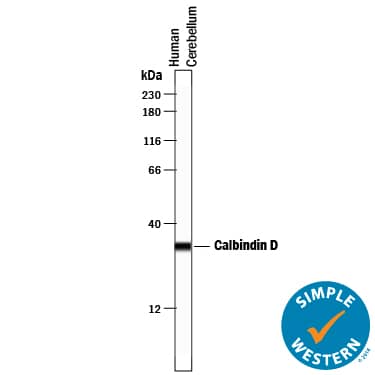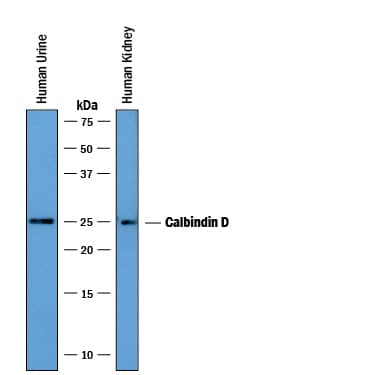Human Calbindin D Antibody
R&D Systems, part of Bio-Techne | Catalog # AF3320

Key Product Details
Species Reactivity
Validated:
Human
Cited:
Human, Mouse
Applications
Validated:
Immunohistochemistry, Simple Western, Western Blot
Cited:
ELISA Development (Detection), Immunohistochemistry, Immunohistochemistry-Paraffin
Label
Unconjugated
Antibody Source
Polyclonal Goat IgG
Product Specifications
Immunogen
E. coli-derived recombinant human Calbindin D
Ala2-Asn261
Accession # P05937
Ala2-Asn261
Accession # P05937
Specificity
Detects human Calbindin D in direct ELISAs and Western blots.
Clonality
Polyclonal
Host
Goat
Isotype
IgG
Scientific Data Images for Human Calbindin D Antibody
Detection of Human Calbindin D by Western Blot.
Western blot shows human urine and lysates of human kidney tissue. PVDF membrane was probed with 5 µg/mL of Goat Anti-Human Calbindin D Antigen Affinity-purified Polyclonal Antibody (Catalog # AF3320) followed by HRP-conjugated Anti-Goat IgG Secondary Antibody (Catalog # HAF019). A specific band was detected for Calbindin D at approximately 25 kDa (as indicated). This experiment was conducted under reducing conditions and using Immunoblot Buffer Group 1.Detection of Human Calbindin D by Simple WesternTM.
Simple Western lane view shows lysates of human brain (cerebellum) tissue, loaded at 0.2 mg/mL. A specific band was detected for Calbindin D at approximately 32 kDa (as indicated) using 10 µg/mL of Goat Anti-Human Calbindin D Antigen Affinity-purified Polyclonal Antibody (Catalog # AF3320) . This experiment was conducted under reducing conditions and using the 12-230 kDa separation system.Calbindin D in Human Brain (Hippocampus).
Calbindin D was detected in immersion fixed paraffin-embedded sections of human brain (hippocampus) using Goat Anti-Human Calbindin D Antigen Affinity-purified Polyclonal Antibody (Catalog # AF3320) at 3 µg/mL for 1 hour at room temperature followed by incubation with the Anti-Goat IgG VisUCyte™ HRP Polymer Antibody (VC004). Before incubation with the primary antibody, tissue was subjected to heat-induced epitope retrieval using Antigen Retrieval Reagent-Basic (CTS013). Tissue was stained using DAB (brown) and counterstained with hematoxylin (blue). Specific staining was localized to neuronal cell bodies and synaptic vesicles. Staining was performed using our protocol for IHC Staining with VisUCyte HRP Polymer Detection Reagents.Applications for Human Calbindin D Antibody
Application
Recommended Usage
Immunohistochemistry
3-15 µg/mL
Sample: Immersion fixed paraffin-embedded sections of human brain (hippocampus)
Sample: Immersion fixed paraffin-embedded sections of human brain (hippocampus)
Simple Western
10 µg/mL
Sample: Human brain (cerebellum) tissue
Sample: Human brain (cerebellum) tissue
Western Blot
5 µg/mL
Sample: Human urine and human kidney tissue
Sample: Human urine and human kidney tissue
Formulation, Preparation, and Storage
Purification
Antigen Affinity-purified
Reconstitution
Reconstitute at 0.2 mg/mL in sterile PBS. For liquid material, refer to CoA for concentration.
Formulation
Lyophilized from a 0.2 μm filtered solution in PBS with Trehalose. *Small pack size (SP) is supplied either lyophilized or as a 0.2 µm filtered solution in PBS.
Shipping
Lyophilized product is shipped at ambient temperature. Liquid small pack size (-SP) is shipped with polar packs. Upon receipt, store immediately at the temperature recommended below.
Stability & Storage
Use a manual defrost freezer and avoid repeated freeze-thaw cycles.
- 12 months from date of receipt, -20 to -70 °C as supplied.
- 1 month, 2 to 8 °C under sterile conditions after reconstitution.
- 6 months, -20 to -70 °C under sterile conditions after reconstitution.
Background: Calbindin D
Long Name
Vitamin D-dependent Calcium-Binding Protein
Alternate Names
CABP, CABP1, CABP28K, CABP9K, Calbindin 3, Calbindin-D, Calbindin-D9K, S100G
Gene Symbol
S100G
UniProt
Additional Calbindin D Products
Product Documents for Human Calbindin D Antibody
Product Specific Notices for Human Calbindin D Antibody
For research use only
